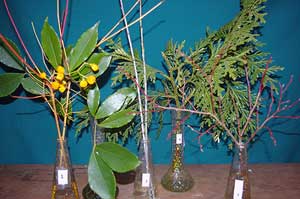December Color Appears at the Washington Park Arboretum (Part II)
1) Cornus sanguinea ‘Midwinter Fire’
(Midwinter Fire Dogwood)
- Perhaps the first dogwood to show its bright winter stems, Midwinter Fire will continue to be the show-stopper of the twig bed until dressed in leaves again.
- You will have no trouble finding this shrub in the Witt Winter Garden.
2) Euonymus myrianthus (Spindle Tree)
- This bushy, evergreen shrub has bright orange-yellow fruit which split open to reveal the showy red arils of the seeds.
- This spindle tree is native to China and is growing among our Asiatic Maples.
3) Salix irrorata (Bluestem, Sandbar Willow)
- This upright shrub from the southwest U.S. has purple to lavender shoots, which have a white bloom in the winter.
- This willow is coppiced each year to maximize its showy shoots.
4) Thujopsis dolobrata (Hiba Cedar)
- This beautiful cedar is native to Japan.
- The foliage is similar to our native Thuja, but larger and more lustrous with distinctive white
markings on the undersides. - We have a young specimen in the Woodland Garden and a T.d. var. hondai at the very south end of Azalea Way.
5) Vaccinium uliginosum ssp. occidentale (Western Bog Blueberry)
- The western bog blueberry grows in wet conditions in alpine or cold weather regions including tundra, where it is a major food source for wildlife such as grouse, caribou and bears.
- The leaves of bog blueberry can accumulate heavy metals without harm to the plant, making it valuable in mine prospecting and reclamation.
- A fine specimen is located at the south end of our Asiatic Maple collection.
